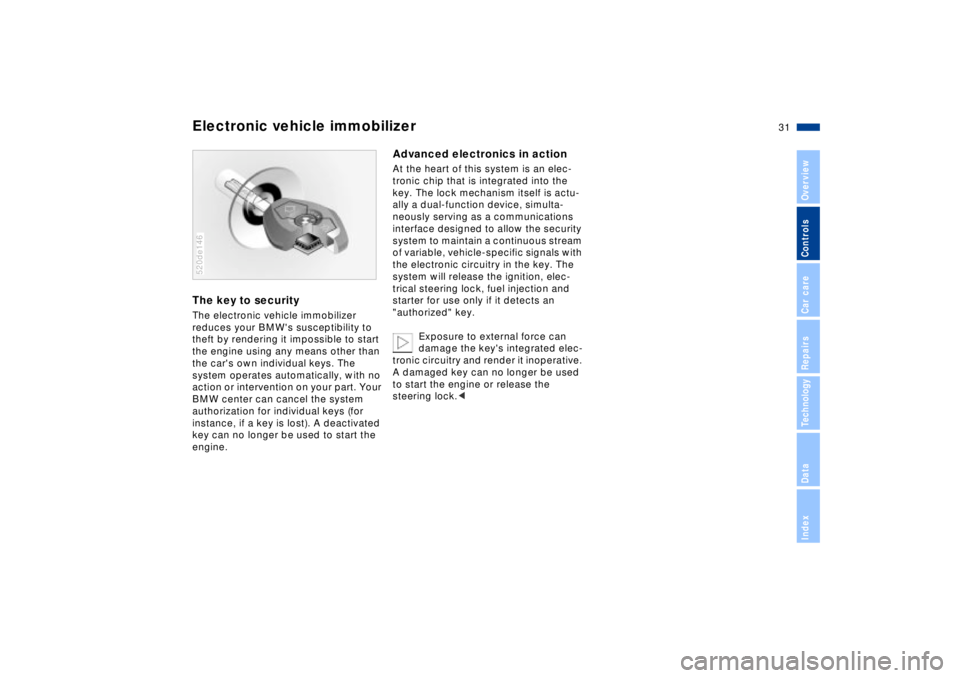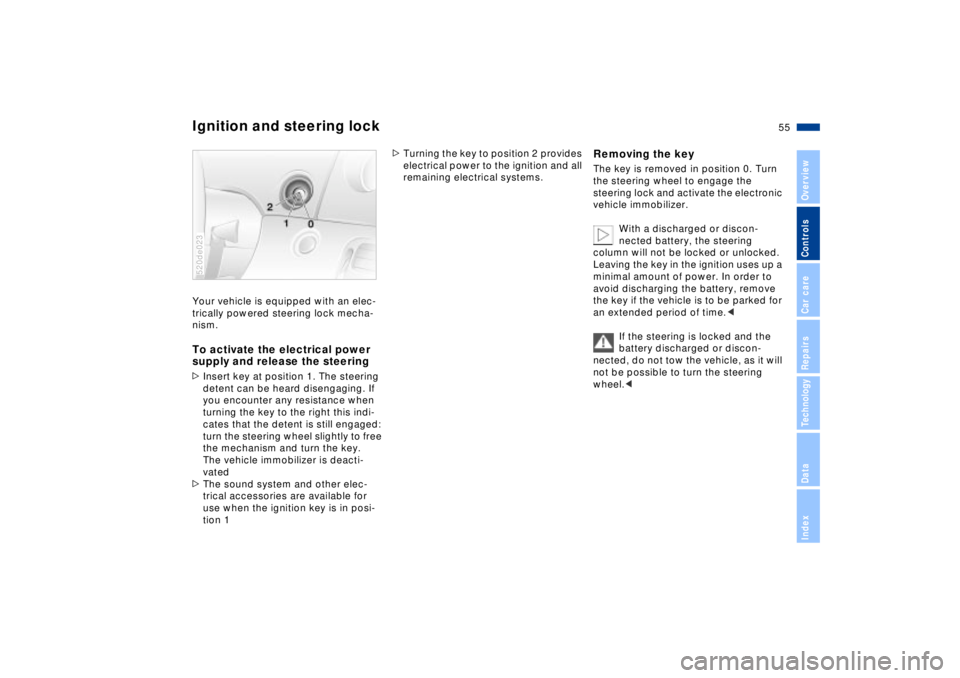2002 BMW Z8 immobilizer
[x] Cancel search: immobilizerPage 10 of 174

Contents
Overview
Controls and features
Cockpit16
Instrument cluster18
Indicator and warning lamps20
Hazard warning flashers24
Warning triangle24
First-aid kit24
Refueling25
Fuel quality26
Tire inflation pressure26
Locks and security systems:
Keys30
Electronic vehicle
immobilizer31
Central locking system32
Opening and closing Ð from the
outside32
Using the key32
Using the remote control33
Opening and closing Ð from the
inside36
Luggage compartment lid37
Alarm system38
Electric power windows40
The automatic convertible
top41
Adjustments:
Seats45
Steering wheel47
Mirrors47
Vehicle Memory, Key
Memory49
Passenger safety systems:
Safety belts50
Airbags51
Transporting children safely53
Driving:
Ignition and steering lock55
Starting the engine56
Switching off the engine57
Parking brake57
Manual transmission58
Turn signal indicator/Headlamp
flasher58
Washer/Wiper system59
Rear window defroster60
Cruise control61
Everything under control:
Odometer62
Tachometer62
Fuel gauge62
Coolant temperature gauge63
Service Interval Display63
Clock64
Multi-Information Radio (MIR)64
Technology for safety and
driving convenience:
Dynamic Stability Control
(DSC)65
Dynamic Performance
Control66
Flat Tire Monitor67
Contents
Page 28 of 174

28n
Locks and security systems:
Keys30
Electronic vehicle
immobilizer31
Central locking system32
Opening and closing Ð from the
outside32
Using the key32
Using the remote control33
Opening and closing Ð from the
inside36
Luggage compartment lid37
Alarm system38
Electric power windows40
The automatic convertible
top41
Adjustments:
Seats45
Steering wheel47
47
Vehicle Memory, Key
Memory49
Passenger safety systems:
Safety belts50
Airbags51
Transporting children safely53
Controls
Page 30 of 174

30n
Keys1 The Key Memory functions are stored
in the remote-control key, refer to
page 49
You can mark individual keys for
subsequent identification by apply-
ingh the colored decals that you
received when accepting delivery of
your vehicle
There is an extended-life battery
in every master key that is
charged automatically in the steering
lock every time you drive.
For this reason, if you have a master
key that is not in regular use, use that
key approximately once every year
while driving for an extended period to
charge the battery. Also refer to
page 33.< 520de142
2 Spare key for storage in a safe place,
such as in your wallet. This master
key is not intended for continuous
use
3 Door and ignition key
The lock for the glove compartment
cannot be operated with this key.
This is recommended for valet
parking, etc.
There is a key case available for using
your master key on a regular basis.
Replacement keysReplacement keys are available exclu-
sively through your BMW center. Your
BMW center is obligated to ensure that
a person requesting a key is authorized
to do so, since the keys are an integral
element of the security system (refer to
"Electronic vehicle immobilizer" in the
following columns).
If possible, take all of the master
keys that belong to the vehicle
with you when you pick up your
replacement key.
Whenever you receive a new replace-
ment key, turn it once to position 2 in
the ignition lock (ignition switched on)
and then back, so that the electronic
vehicle immobilizer can initialize the
new key.<
Page 31 of 174

31n
IndexDataTechnologyRepairsCar careControlsOverview
Electronic vehicle immobilizer The key to securityThe electronic vehicle immobilizer
reduces your BMW's susceptibility to
theft by rendering it impossible to start
the engine using any means other than
the car's own individual keys. The
system operates automatically, with no
action or intervention on your part. Your
BMW center can cancel the system
authorization for individual keys (for
instance, if a key is lost). A deactivated
key can no longer be used to start the
engine.520de146
Advanced electronics in actionAt the heart of this system is an elec-
tronic chip that is integrated into the
key. The lock mechanism itself is actu-
ally a dual-function device, simulta-
neously serving as a communications
interface designed to allow the security
system to maintain a continuous stream
of variable, vehicle-specific signals with
the electronic circuitry in the key. The
system will release the ignition, elec-
trical steering lock, fuel injection and
starter for use only if it detects an
"authorized" key.
Exposure to external force can
damage the key's integrated elec-
tronic circuitry and render it inoperative.
A damaged key can no longer be used
to start the engine or release the
steering lock.<
Page 55 of 174

55n
IndexDataTechnologyRepairsCar careControlsOverview
Your vehicle is equipped with an elec-
trically powered steering lock mecha-
nism.To activate the electrical power
supply and release the steering>Insert key at position 1. The steering
detent can be heard disengaging. If
you encounter any resistance when
turning the key to the right this indi-
cates that the detent is still engaged:
turn the steering wheel slightly to free
the mechanism and turn the key.
The vehicle immobilizer is deacti-
vated
>The sound system and other elec-
trical accessories are available for
use when the ignition key is in posi-
tion 1 520de023
>Turning the key to position 2 provides
electrical power to the ignition and all
remaining electrical systems.
Removing the key The key is removed in position 0. Turn
the steering wheel to engage the
steering lock and activate the electronic
vehicle immobilizer.
With a discharged or discon-
nected battery, the steering
column will not be locked or unlocked.
Leaving the key in the ignition uses up a
minimal amount of power. In order to
avoid discharging the battery, remove
the key if the vehicle is to be parked for
an extended period of time.<
If the steering is locked and the
battery discharged or discon-
nected, do not tow the vehicle, as it will
not be possible to turn the steering
wheel.<
Ignition and steering lock
Page 167 of 174

Everything from A to Z
167n
IndexDataTechnologyRepairsCar careControlsOverview
Connector for Onboard
Diagnostic126
Consumption display62
Controls16
Convertible top41
closing in event of
electrical
malfunction143t
manual operation143t
Coolant113, 161
Coolant temperature
gauge63
Copyright4
Cornering Brake Control
(CBC)21, 89
Cruise control61
Curb weight160
Current check indicator20DDashboard16
Data
dimensions159
engine158
technical158
weights160
Daytime driving lamps69
DBC (Dynamic Brake
Control)90
Deactivating the tilt alarm
sensor and interior motion
sensor34Deep water87
Defrosting the
windows60, 75
Difficult steering20, 94
Dimensions159
Dipstick111
Disc brakes90
Displacement158
Display lighting69
Displays18
Disposal
engine oil113
used batteries140t
Door keys30
Door warning lamp, bulb
replacement134t
Doors
emergency
actuation32t
mirrors48
remote control33
unlocking and locking32
DOT Quality Grades100
Draft-free ventilation75
Drink holder78, 80
Drive belts162
Driving in winter92
Driving notes87
DSC (Dynamic Stability
Control)22, 65, 152
Dynamic Brake Control
(DBC)90Dynamic Performance
Control66
Dynamic Stability Control
(DSC)22, 65, 152
EElectric defrosting of
mirrors48
Electric power seats45
Electric power windows40
Electrical equipment
failure140t
Electrical failure
convertible top143t
doors32t
fuel filler door142t
luggage
compartment142t
passenger-side
door143t
Electrical system162
Electronic vehicle
immobilizer31
Emergency operation
convertible top143t
doors32t
fuel filler door142t
luggage
compartment142t
passenger-side
door143tEmergency release from
luggage compartment's
interior38
Engine
coolant113, 161
data158
output158
speed158
starting56
switching off57
Engine compartment108
Engine oil111
add111t
consumption111
filling capacity161
filter change161
pressure indicator
lamp20
quality112
specifications112
viscosity112
Engine oil level
check111
Equipment
options and accessories5
Exit lamps, bulb
replacement134
Exterior finish119
Exterior mirrors48
Page 170 of 174

Everything from A to ZRestraint systems53
Return used
batteries140t
Reverse17, 58
Roof load capacity160
Rotating the tires101
Rubber parts93SSafety belt tensioners153
Safety belts50
Safety buttons36
Safety tires99
Seat adjustment45
Seat heating77
Securing cargo83
Self-defrosting mirrors48
Service Interval
Display63, 116
Shelves78, 79
Should131t
Side airbags51
Side marker lamps69
bulb
replacment131t, 132t
Skid control94
Slippery roads93
Snow chains93, 103, 104
Socket82
for flashlights82
for power supplies82
for vacuum cleaners82Sound system, refer to the
separate Owner's Manual
Spare key30
Spark plugs162
Speaker81
Specified engine oil112
Speedometer18
Starting56
problems87t, 145
Steel wheels104
Steering94
Steering wheel lock55
Stopping the vehicle57
Storage areas78, 79
Storing your vehicle124
Stroke158
Summer tires102
Switching off the engine57
Switching off the interior
motion sensor39t
Switching off the tilt alarm
sensor39t
Symbols4, 138
TTachometer62
Tail lamps132
bulb replacment132t
Tank capacity161
Technical data158
Technical
modifications6, 125Telephone81
Temperature display
outside temperature64
Temperature gauge
engine coolant63
Temperature
selection74, 75
Tilt alarm34
Tilt alarm sensor39
Tire codes102
Tire damage99t
Tire inflation
pressure26, 99
Tire pressure monitor67
Tire replacement100, 101
Tire rotation101
Tire specifications104
Tire tread99
Tools130t
Torque158
Tow fittings146t
Towing the vehicle146t
Tow-starting146t
Track159
Traction Control System
refer to DSC65
Transmission58
Transmitter key30
Tread depth, tires99
Trip odometer62
Trunk lid, refer to luggage
compartment lid37Turn signal indicator23, 59
Turning circle159
UUniform Tire Quality
Grading101
Unusually high steering
effort20, 94
Use antifreeze114t
radiator114t
Used batteries,
disposal140tVVacuum cleaner82
Vehicle battery138, 162
Vehicle care
exterior119
interior121
Vehicle equipment
options and accessories5
Vehicle Identification
Number (VIN)115
Vehicle immobilizer31
Vehicle painting119
Vehicle storage124
Vehicle weight160
Vehicle, starting56
Vehicle, stopping57
Ventilation72
draft-free75
Vinyl upholstery, care121